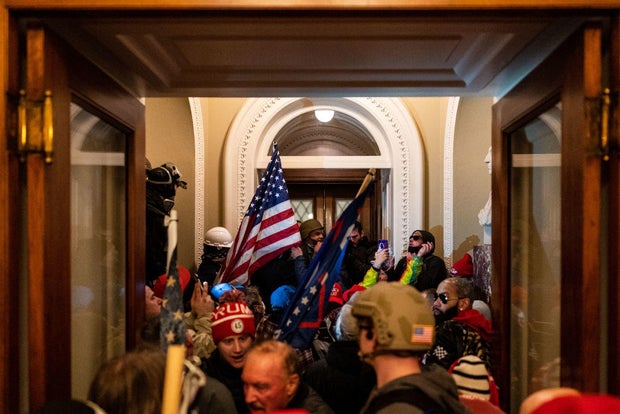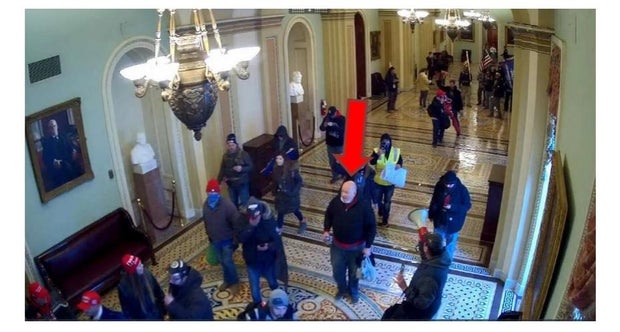washington – Almost 3 and a half years after the Siege of the US Capitolthe government recovered only a fraction of court-ordered restitution payments for reparations, police injuries, and cleaning up damage caused by protesters.
Hundreds of offenders who pleaded guilty or were convicted for their roles in the attack on the Capitol were ordered to pay for injuries to the police officers who defended the Capitol and to reimburse the architect of the Capitol to help offset the repair costs as a result of damage that occurred on January 6, 2021.
Although the Justice Department and Capitol administrators estimated that cleaning and repair costs were almost $3,000,000approximately 15% of the money has been returned so far, according to a CBS News analysis.
Kent Nishimura/Los Angeles Times via Getty Images
A congressional source familiar with the matter told CBS News that approximately $437,000 was reimbursed by the January 6 violators to the architect of the Capitol.
Government document
Court-ordered restitution, often ranging between $500 and $2,000 per Jan. 6 offender, has become a standard component of sentencing — at least 884 have been convicted so far.
But CBS News has learned that payments have been slow and federal taxpayers are far from made whole as some offenders argue they are having difficulty getting the money. Another factor is that the court system and federal government have allowed a lenient deadline for restitution payments.
“Those who were incited by the former president to violently attack the Capitol and impede the peaceful transfer of power owe taxpayers money,” said Representative Joe Morelle, Democrat of New York and ranking member of the House Administration Committee, which oversees the Complex of the Capitol.
“The money they owe is to pay repairs for the damage President Trump inspired them to inflict,” Morelle told CBS News,
In the 41 months since the attack, federal taxpayers have footed the bill for a series of repairs to the Capitol complex and the costs of those injured and the deployment of law enforcement officers who responded. Historic windows were broken. Police equipment was stolen. Cops have suffered injuries and continue to need medical coverage. A CBS News analysis of Justice Department records shows that nearly 150 police officers were assaulted on January 6. A similar number reported suffering injuries.
Federal judges exercised some flexibility and allowed a long window for offenders to make restitution payments. In some cases, courts allowed them to pay small monthly installments, and only after they were released from prison sentences. In cases reviewed by CBS News, offenders were allowed to make payments as low as $250 per month. Some have not yet started payments due to ongoing prison sentences.
Government document
A number of offenders cited financial difficulties. James Small, a 53-year-old truck driver from Claremont, North Carolina, pleaded guilty to illegal picketing and parading. At his sentencing hearing in January 2024, he told the judge: “Because of the January 6th situation and the publicity about it, I have had a lot of difficulties in my career over the last three years.” He added: “So to begin with, it’s been a financial struggle for me. And I actually had to borrow money from my mother.”
D.C. Delegate Eleanor Holmes Norton, a Democrat, demanded that the offenders pay for the damage they caused.
“DC suffered significant damage due to the barbaric January 6th attack, and it is outrageous that only 16% of the court-ordered restitution has been paid by the perpetrators more than three years later,” Norton said in a statement. “DC, which bears the burden of hosting the federal government and pays the highest federal taxes per capita in the country, must recover.”
To further complicate matters for the architect of the Capitol, the agency has faced obstacles in accessing the money paid so far. A congressional aide familiar with the matter told CBS News that $437,000 in payments collected so far have been transferred to an account at the Treasury Department, as required under current law. House members will consider adding language and provisions to an upcoming government funding bill to allow the Architect of the Capitol to more easily access and deposit Jan. 6 restitution funds.
The Justice Department regularly cites the widespread damage and impact of the attack when asking the court to order restitution of January 6th sentencing hearings. High-profile offenders, including those who were convicted of conspiracy, were ordered to pay $2,000 each. Lower-level offenders, including those who did not engage in violence or robbery, were required to pay $500.
In a February 2022 court filing in the case of Roberto Schornakthe Justice Department said refunds from violators were needed to offset the “cost of damage to the Capitol building and grounds, the costs associated with deploying additional law enforcement units at the Capitol, the cost of broken law enforcement equipment or damaged, the cost of stolen property, and costs associated with bodily injuries suffered by law enforcement officers and other victims.”
The costs incurred for helping injured police officers were cited in some January 6 criminal cases. In the sentence of March 21, Jeffrey Sabolthe judge said the cost of leave and treatment for a Washington, D.C. Metropolitan Police officer has exceeded $30,000 so far.
Sabol’s defense attorney cited likely challenges to Sabol’s ability to promptly pay restitution in his case. At Sabol’s sentencing hearing on March 21, Judge Rudolph Contreras said, “The defendant has been detained for almost 3 years and therefore has not been able to earn a living. Otherwise, he will have no assets and will have to pay compensation .”
Former President Trump publicly promised to forgive defendants Jan. 6, but did not specify whether he would also seek to commute his restitution payments. The Justice Department considered completion of restitution payments as part of its criteria when deciding whether to support a defendant’s request for pardon.
A person familiar with the process said defendants typically discuss with their probation officers the term and amount they can pay. This usually occurs during the period of supervised release and the payment schedule is set according to what probation officers deem feasible.
But the Justice Department website says “the chance of full recovery is very low” because “[m]any defendants will not have sufficient assets to reimburse their victims.”
gshow ao vivo
email uol pro
melhor conteudo
mãe png
cadena 3
tudo sobre
absol


























